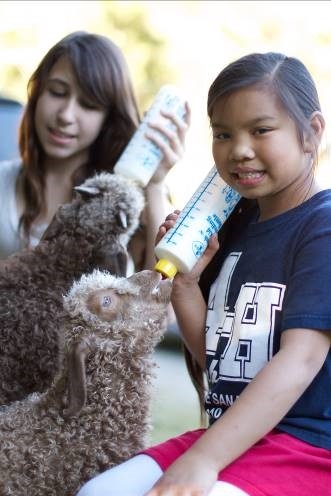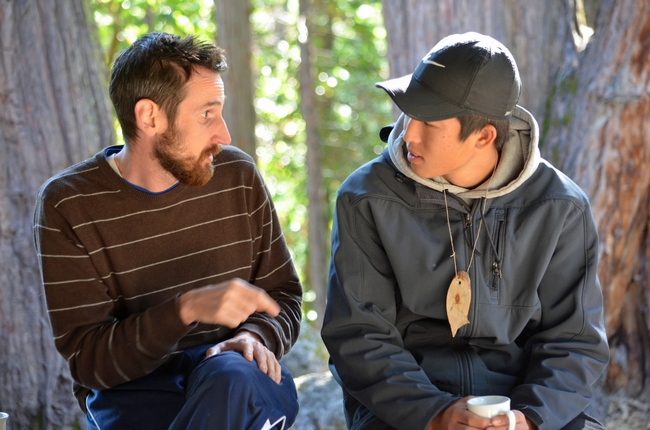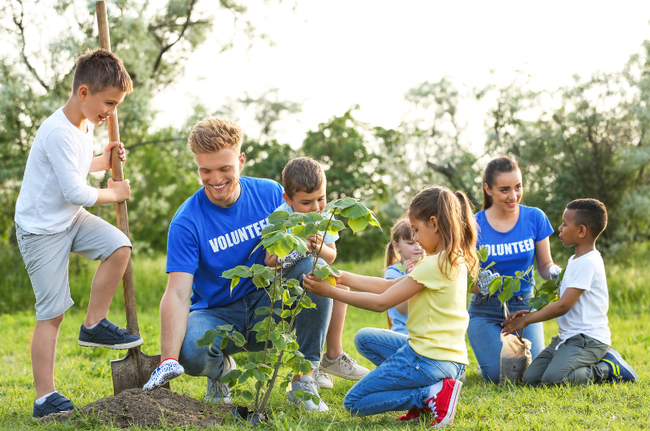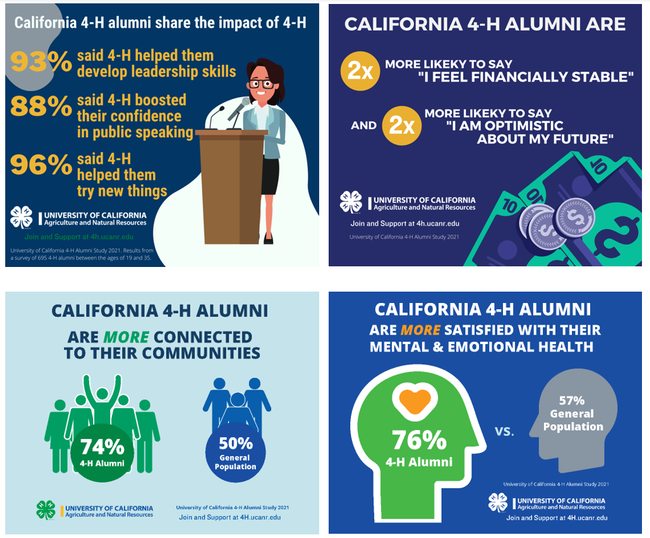- Author: Marianne Bird
My favorite part of our Sacramento 4-H volunteer orientation comes when we introduce the 4-H Thriving Model (Arnold, 2018). “Think back to when you were a child or a teenager,” we ask. “Other than your parents, was there an adult—a coach, a teacher, a neighbor—who was special? What made them so?” As participants take a moment to remember, to share with a partner then perhaps with the larger group about this individual, the conversation deepens.
“I had a teacher who nominated me for an honor. She saw something in me that I didn't see in myself.”
“Every night at bedtime my camp counselor would spend a few minutes asking questions and just listening about our day. I bonded with them and our cabin group bonded with each other.”
“My high school economics teacher pushed me in a subject area completely new to me, and it was a turning point in how I engaged in learning.”
As I listen to these stories, I can't emphasize enough how important relationships with caring adults are in youth development work. In the 4-H Thriving Model, relationships are characterized as part of the “soil”—the foundational element—critical to a young person's (and I'd argue, anyone's) growth. Nutrient-rich soil grows strong plants. Or, as the metaphor goes, positive, caring adults develop healthy, capable youth.
What are the qualities of a caring adult? To cultivate strong relationships, consider the following.
- Express Care: What things can you do to help a young person feel special and important to you? Do you know not only their name, but a bit about who they are, what they enjoy, perhaps what they find difficult? Do you celebrate their successes?
- Challenge Growth: How do you engage youth in learning? How do you encourage goal setting and practice? Do you build in time for youth to reflect not just in their project, but on their leadership, teamwork, and responsibilities?
- Provide Support: What do the youth you work with need from you? Encouragement? Check-ins? Coaching? Have you asked them how you can best support their efforts?
- Share Power: How well do you build your program with young people, not just for young people? Do they share their thoughts with you? Do they assume leadership roles? How might you listen better to incorporate their ideas into your project?
- Expand Possibilities: What can you do to help youth see and connect with a bigger future? Might you bring in speakers or plan for field trips to explore education or career possibilities? For older youth, are there doors you might open or connections you might facilitate?
There is no greater compliment than when an adult looks back and says, “You made a difference in my life.” Each one of us is in a position to be that special person. What a gift.
Marianne Bird, 4-H Youth Development Advisor
mbird@ucanr.edu
Arnold, M. E. (2018). From context to outcomes: A thriving model for 4-H youth development programs. Journal of Human Sciences and Extension, 6 (1), 141-160.
- Author: JoLynn Miller
Volunteering may be the answer to bringing people together, in a time where there seems to be more division than ever. The Census Bureau and AmeriCorps report that while formal volunteering rates have declined, informal volunteering rates have remained steady. Last year, I discussed the many personal benefits to volunteering (longer lifespan, potential job skills, increased self-confidence, etc.). This year as National Volunteer Month comes to a close, I suggest looking at it from a different angle.
By volunteering, formally or informally, you are strengthening our community. We build social capital together. Dr. Nathaniel, a 4-H Advisor in Los Angeles county and researcher of social and community capital, writes, “Youth who are engaged in community service tend to have higher degrees of social capital. That is, youth who are engaged in at least 5 community service projects where they are involved with the conceptualization, design, planning, and execution of a community service project are more connected to community networks, resources, and institutions.” Furthermore, Dr. Worker, a 4-H Advisor in Marin, Sonoma, and Napa counties, found that besides skill development, increased well-being, and gratification from working with youth and other adults, 4-H volunteers strengthened social development, including developing friendships, strengthening family connections, and ties with the broader community.
As a life-long volunteer myself, I have experienced these things firsthand. Over the years, in four different communities, I've spent time volunteering as a way to make connections and learn about my neighbors. Some highlights have been teaching Red Cross First Aid and CPR classes, starting a livestock evacuation team, and being a foster dog mom. In each instance, I've met people with similar interests and passions for making a difference, and even formed lasting friendships. I also learned many of the people working side by side with me had different political views, different religions, and/or different worldviews. And it didn't matter where we differed because we were able to focus on the task at hand. Helping where help was needed.
Whether it be teaching a child about robotics in 4-H or helping animals find their fur-ever home, when you volunteer for a community organization that you're passionate about, you are inevitably making connections to others with the same goal in mind. When you're out picking up trash with a stranger, you're able to join forces, start a task, enjoy each others company while working, and feel accomplished together when the work is complete. Volunteering has the potential to break down the walls between us. It can bridge the gaps.
As the nation sees volunteer rates decline, I implore youth and families to find volunteer opportunities within their community though 4-H or otherwise. The services many non profits provide wouldn't be possible without volunteers; services the community has come to rely on-like food assistance, youth activities, veterans' services, fire and disaster safety, and more. Remember that not only will you be helping fill a specific need in the community, you'll also be building a strong one.
JoLynn Miller is a 4-H Youth Development Advisor with University of California Agriculture and Natural Resources. She is responsible for four counties in the Central Sierra and focuses her research on volunteerism, volunteer development, youth retention, and working with youth in the juvenile justice system. You can contact her at 209-533-5686 or jlmiller@ucanr.edu.
- Author: Nicole Marshall-Wheeler
From Youth to Competent Adults: The Long-Term Outcomes of 4-H
Participating in the 4-H Youth Development Program can be rewarding for youth in many ways. Often youth participate in programs or projects which help them cultivate new skills or gain confidence while having fun.
The ultimate goal of most youth development programs, such as 4-H, is to help youth grow into capable adults, while providing a valuable experience during childhood. Adult volunteers and 4-H professional staff dedicate years and emotionally invest in local youth to help them grow. So how do we know that our youth development programs are making a lasting impact? Is our hard work paying off in the long run, as youth grow into adults?
Many programs, including the 4-H Youth Development program, report short-term behavior or attitude changes their program has had on the participating youth members during the course of the program or during a single snapshot in their time in the program. These short-term behavior or attitude changes are a great way of knowing the change happening during or immediately after participating in a youth program. Determining the long-term impacts of a youth program can be more challenging though. We sometimes see immediate changes, but do those changes last into adulthood? One way to look at long-term impacts of youth programming is to ask alumni or program participants who have aged out of a program to reflect on their time in the program.
In a recent study, a team of 4-H academics surveyed 693 California 4-H young adult alumni to find out what past 4-Her's report as the benefits and outcomes of the 4-H program. The research team focused on young adults aged 19 to 34, knowing that the 4-H program has changed its structure and framework over the years. 4-H alumni were asked questions around three main areas: economic stability, health and well-being, and community involvement.
Lifelong Outcomes
The results of this study showed that California 4-H alumni had many positive long-term outcomes from involvement in the California 4-H Youth Development Program. When compared with a U.S. general population who had not participated in 4-H, the 4-H alumni demonstrated more positive long-term outcomes in each of the three areas. Not only did 4-H alumni report a strong sense of community, better physical and mental health, and feeling more financially stable – they also confirmed that 4-H helped them develop leadership, public speaking, and other real-world skills.
Ultimately, projects and programs in 4-H help youth develop skills and confidence in a way which has a lasting impact. Our time, effort, and valiant efforts with youth will most likely follow these youth into adulthood and beyond.
References:
Marshall-Wheeler, N., Nayak, R., Iaccopucci, A., & Worker, S. M. (2023). Long-term outcomes of early adult 4-H alumni. The Journal of Extension, 61(2), Article 2.
- Author: Russel Hill
The Benefits of Volunteering
Volunteering with 4-H can be a rewarding experience that not only helps young people but also benefits the volunteers themselves. Science, technology, engineering, and mathematics (STEM), healthy living, leadership, and civic engagement are but some of the broad categories of hands-on learning experiences that 4-H provides under the umbrella of positive youth development. Here are some of the benefits of volunteering with 4-H:
1. Making a Positive Impact
Volunteering with 4-H allows you to make a positive impact on young people's lives. By sharing your knowledge and skills, you can help youth develop new skills and interests. You can also serve as a role model and mentor, helping youth build confidence and self-esteem.
2. Developing New Skills
Volunteering with 4-H can help you develop new skills and knowledge. As a volunteer, you may have the opportunity to learn about new topics or gain experience in areas such as teaching, public speaking, and leadership. These skills can be valuable in your personal and professional life.
3. Building Networks
Volunteering with 4-H can help you build new networks and connections. You can meet other volunteers who share your interests and values, as well as connect with community leaders and professionals. These connections can help you build your personal and professional network.
4. Having Fun
Volunteering with 4-H can be a fun and rewarding experience. You can participate in hands-on activities, attend events and workshops, and interact with youth who are enthusiastic and eager to learn. You can also develop new friendships and enjoy the camaraderie of working with other volunteers.
5. Making a Difference in Your Community
Volunteering with 4-H allows you to make a difference in your community. By helping young people develop skills and knowledge, you can contribute to the well-being of your community and help create a brighter future for everyone.
6. Science Backs the Benefits of Volunteerism
- According to a study published in the Journal of Personality and Social Psychology, volunteering can enhance well-being and reduce symptoms of depression. [1]
- A report from the Corporation for National and Community Service found that volunteering can improve job prospects and increase employability. [2]
- A study published in the Journal of Health Psychology found that volunteering can lead to a sense of purpose and meaning in life. [3]
- According to a report from the National Conference on Citizenship, volunteering can promote social connectedness and increase civic engagement. [4]
- A study published in the Journal of Gerontology found that volunteering can improve physical health and increase longevity. [5]
7. Examples of Volunteering in 4-H
- Leader: As a leader volunteer, you can lead a 4-H project or activity in your area of expertise. This could involve teaching youth about animal husbandry, gardening, or robotics, for example. You would work with a group of youth on a regular basis, helping them develop skills and knowledge in your area of expertise. If you have a specific skill or interest, you can volunteer to lead a 4-H project. This could involve organizing a workshop or event, or providing guidance and support to youth as they work on a project. For example, if you are a skilled chef, you could lead a cooking project and teach youth how to cook their own meals.
- Mentor: As a mentor, you can work one-on-one with youth to help them develop skills and interests. This could involve providing guidance and support as they work on a project or helping them develop leadership skills. You would work closely with a youth over a period of time, providing ongoing support and encouragement.
- Judge or Evaluator: If you have expertise in a particular area, you can volunteer to serve as a judge or evaluator for 4-H events. This could involve judging a livestock show, evaluating a science fair project, or providing feedback on a public speaking contest. You would use your expertise to provide feedback and support to youth as they participate in 4-H events.
- Event Volunteer: You can also volunteer to help at 4-H events. This could involve setting up and taking down equipment, helping with registration, or serving as a chaperone. You would work with other volunteers to ensure that events run smoothly, and that youth have a positive experience.
These are just a few examples of the many ways you can volunteer with 4-H. No matter what your skills or interests are, there is likely a way for you to get involved and make a difference in the lives of young people. Volunteering with 4-H can be a rewarding experience that offers many benefits. If you are interested in volunteering with 4-H, contact your local 4-H office to learn more about opportunities in your area.
Sources:
- https://psycnet.apa.org/record/2010-09305-015
- https://www.nationalservice.gov/sites/default/files/resource-library/employment_impact_of_volunteering.pdf
- https://journals.sagepub.com/doi/abs/10.1177/1359105317695852
- https://www.ncoc.org/sites/default/files/NCOC%20Volunteering%20and%20Civic%20Life%20in%20America%20Report_0.pdf
- https://academic.oup.com/gerontologist/article/38/5/569/654051
- Author: Steven Worker
- Author: Martin Smith
The 4-H Youth Development Program has a long and proud history in California's agricultural communities. The 4-H program, administered by the University of California Cooperative Extension, helps youth develop into capable and successful adults by engaging them in agricultural, science, leadership, and civic education.
Animal science projects are a hallmark of the 4-H program and thousands of young people – from rural, suburban, and urban areas – enroll in these 4-H projects annually. In these projects, a primary focus is on the rearing, caring, showing, and marketing of animals, with some projects centered on breeding. Animal science projects offer youth an array of learning experiences providing opportunities for improved scientific and agricultural literacy and contribute to positive youth development. More specifically, youth learn skills such as leadership, public speaking, goal setting, responsibility, and caring that provide the foundation for successful, healthy development. These experiences help prepare the next generation of farmers, ranchers, foresters, veterinarians, and agricultural scientists.

Reducing the risk of disease spread
While 4-H promotes agricultural education, the raising and showing of animals poses bio-security risks, and youth need to cultivate an appreciation for and develop the skills necessary to help reduce the risk of disease spread to animals and humans. Youth animal science projects include a variety of species, including poultry, ruminants, and swine that are often raised in backyard flocks or herds or on local farms. Additionally, these 4-H youth often travel with their animals multiple times to present at club meetings fairs, shows, and exhibitions, and these trips can be at the local, regional, state, and national levels. Because backyard flocks and herds serve as potential vectors of disease, these public venues represent significant biosecurity risks, including: mixing of animals from multiple premises; lack of or insufficient quarantine procedures; and inadequate sanitation practices. Exposure of disease to animals at fairs, shows, or exhibitions, either accidentally or intentionally, could be catastrophic to U.S. agriculture, both financially and through the loss of animal life. Developing good bio-security practices among youth who raise and show animals can help mitigate potential animal disease outbreaks and is essential to the long-term safety and security of animal agriculture in California.
Animal welfare
The study of animal welfare is a rapidly growing field that engages scientists and veterinarians in research that seeks to provide better understanding of the needs and experiences of animals and strives to find a balance between these and the practices of modern animal use. Animal welfare is a social and cultural issue that is increasingly being incorporated into the legal and political landscapes. Due to the complex nature of the subject of animal welfare, it is necessary to approach this issue in a partnership between the University of California, 4-H, the agricultural industry, and local farmers and ranchers to educate and support youth and 4-H volunteers in a sustained fashion. Furthermore, it is essential that 4-H youth have the opportunities to engage in educational experiences that provide them an understanding of foundational animal welfare concepts, help them develop the skills necessary to make cogent assessments of their project animal's well-being, and are grounded in authentic practice.
4-H Curricula
The University of California Cooperative Extension is leading the way in supporting youth and educators to take responsibility for proper care and treatment of their animals and support good bio-security practices. Through new research-based curricula, 4-H supports proper management practices for the care and treatment animals. New curricula utilize hands-on experiential learning where youth have a concrete hands-on experience; a reflection phase to share, process, and generalize from the experience; and application of learning in new and authentic situations. Curricula currently available include: Bio-Security at http://ucanr.edu/bio; Pre-Harvest Food Safety in 4-H Animal Science at http://ucanr.edu/harvest; Veterinary Science at http://ucanr.edu/vet; and Animal Welfare at https://anrcatalog.ucanr.edu/Details.aspx?itemNo=8644.
Adapted from the original article published in the Sonoma-Marin Farm News, August 2016.






